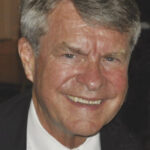Although Television was really introduced to American households in the late 1940s, it was the 1950s that saw the medium gain in both acceptance and sophistication.
You might not know it by looking at what is offered in prime time by national networks today, but 50 years ago, television programming was aiming high, rivaling that found in movie theaters and even the stage.
Many of the scripts, the characterizations, and the actors were as good as you could find anywhere. Rod Serling’s “Requiem for a Heavyweight” for instance, was produced live on TV in 1956, then made into a movie six years later. Both versions were good; I prefer the original version better.
One staple of early television was the seemingly endless reruns of Hollywood westerns from the 1930s and 40s. Names such as Hopalong Cassidy, Hoot Gibson, and Johnny Mack Brown were as well known in most 1950s American households as were the names of President Eisenhower, Winston Churchill, and Joseph Stalin.
But those 60-minute B-westerns were only a harbinger of what TV could be, and in the late 1950s, newly-labeled “adult westerns” began to fill the television landscape. They were the fad of the day; the hip viewer’s choice most weeknights every bit as much as reality shows have satisfied the trendy in the 21st century.
Adult westerns stressed character development more so than action. There was actually a story contained in the script. And that story was far more than simply the cavalry coming to the rescue, or the quiet stranger vanquishing the town bully.
Some of those westerns eventually reached number one in the ratings. Some—like Gunsmoke—stayed on the air for 20 years. Some, like Colt 45, barely made it past the first season.
One of the best, was Wagon Train, beginning in 1957 and running eight seasons, filming 284 episodes. It became the top-rated show in 1961.
Wagon Train was inspired by the 1950 feature film, Wagonmaster, about a group of Mormons traveling through 1840s Utah in search of a home. The television series was one of the best for many reasons, all of which are covered in James Rosin’s latest book, Wagon Train, The Television Series (The Autumn Road Company, ISBN-10: 0972868445).
Rosin, a Philadelphia actor and author of several other books on history—both local (Philadelphia, City of Music) and television (Naked City: The Television Series)—has put together an easy-reading history, listing a synopsis of every episode, while interviewing some of the show’s noted guest stars, like Ernest Borgnine, Dana Wynter, Robert Horton, Denny Miller, Debra Paget, Nehemiah Persoff, and Harry Carey, Jr.
The two major Wagon Train permanent cast members were Ward Bond as the hard-nosed wagonmaster Major Seth Adams, and Robert Horton as Flint McCullough, his dashing young scout.
I majored in History in undergrad school, and there are things I learned in Rosin’s book that got by me during my college studies, and subsequent years of casual reading of American history.
“The trip west (in a wagon train) cost settlers about $1,000,” Rosin noted. The wagon itself was worth about $400, or $8,000 in today’s dollars.
Oxen were the mode of power, rather than the ubiquitous horse of the western genre. Oxen were stronger and less likely to be stolen by plains tribes.
And although the series ran for eight years, a real 1860s journey from Missouri to Oregon took about five months.
Wagon Train boasted some of the top stars of the day in guest roles, which usually were the focus of each individual episode.
Lou Costello, of Abbott and Costello fame, appeared in a 1958 episode shortly before his death. It was the only dramatic appearance Costello ever made on film.
Academy Award winner Borgnine appeared in both the first and last Wagon Train episode, filmed eight years apart.
Perhaps the most unusually aspect of the show was the relationship between stars Horton and Bond. In his interview, Horton stated that he really didn’t relate well to his co-star (Bond died in 1960, and was replaced by actor veteran actor John McIntire) since they had nothing in common, but somehow, they enjoyed a great rapport on camera.
Denny Miller (one of those faces you’ll recognize, but probably not the name) who played Duke Shannon on the show from 1961-64, noted that guest star Bette Davis was a terror to work with, comparing working with her to getting root canal!
There are plenty of black-and-white photos throughout the book, showing the drama, and some behind-the-scenes snaps as well. After the interviews, Rosin appends a biography section—a “where-are-they-now” or “whatever-happened-to” section, if you will.
Rosin has a flare for bringing the 1950s alive in his work, and reminding many of us what made it the memorable time it was. His next project is also a 1950s program—Adventures in Paradise, based on the James Michener novel and staring Gardner McKay.
“McKay is a very unique individual,” Rosin explained. “He didn’t especially like the Hollywood set, so he dropped out of the limelight and traveled the world, eventually becoming a writer.”
Sounds a little familiar. And I bet it’s going to make a very interesting book.








